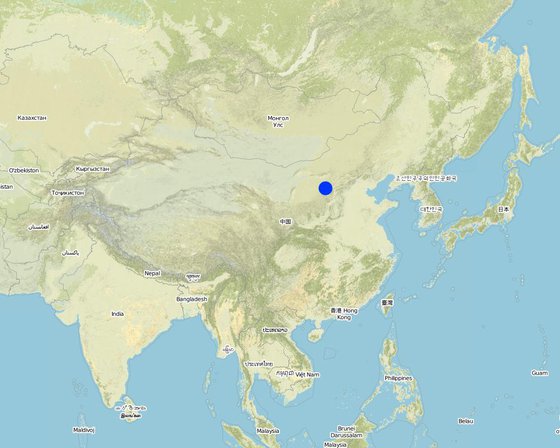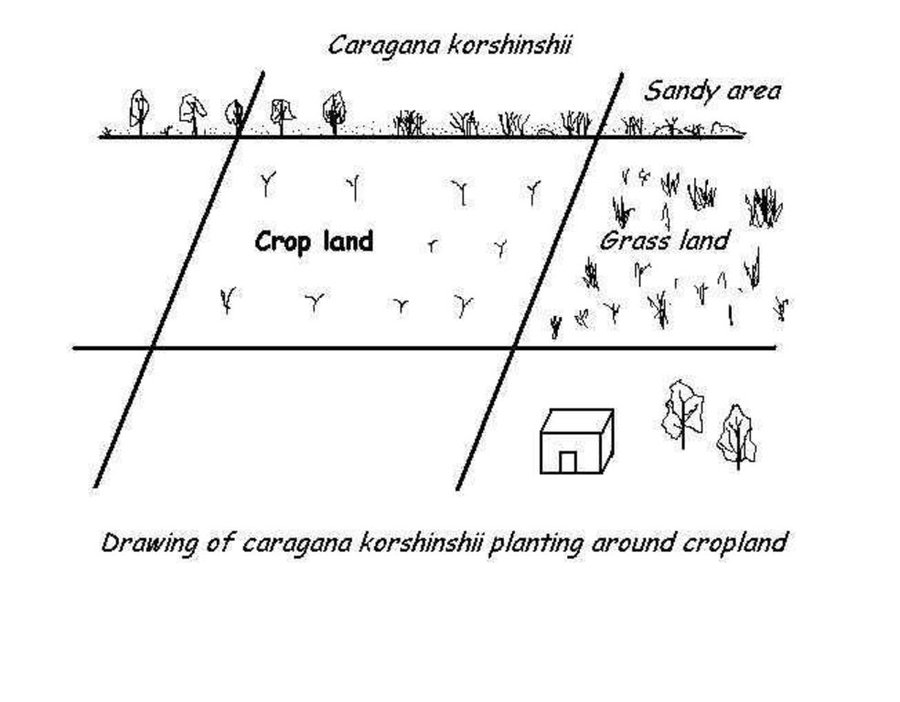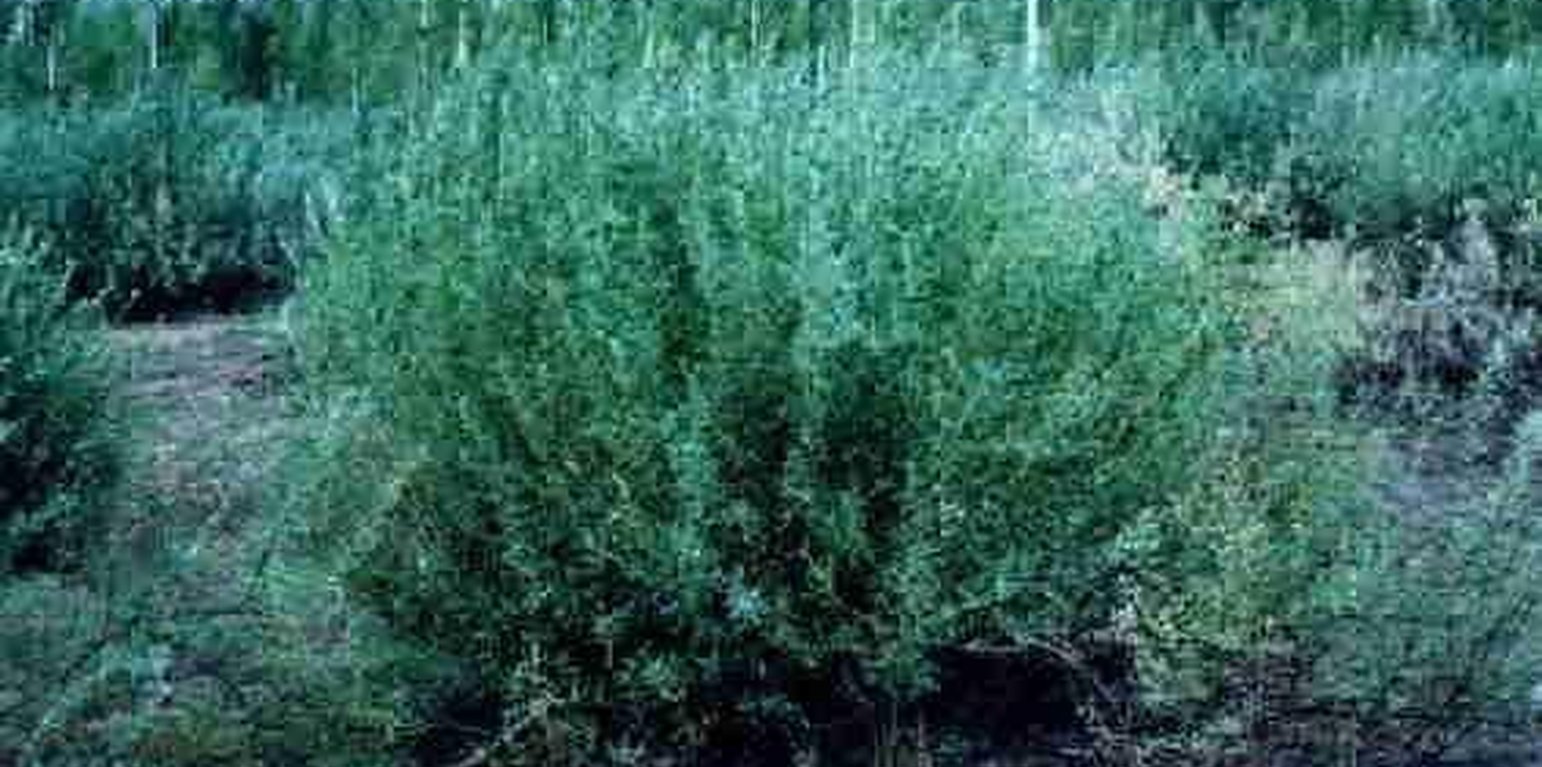Caragana Korshinskii Planting a kind of SWC vegetative technology
(China)
Ning Tiao Planting
Description
Caragana korshinskii, a kind of perennial shrub, is used to protect soil from water and wind erosion, rhizobium in its root can increase soil fertility.
Caragana korshinskii is a kind of perennial and drought resistant shrub being used to protect soil from water and wind erosion. It has long roots in and can extract water from deep soil layers. Its roots with rhizobium can improve soil fertility. So caragana korshinskii can be planted where water and /or wind erosion is serious. Its branch has economic value. In autumn before raining, caragana korshinskii seeds are planted into holes. In the first three or four years, It should be protected from cutting and sheep eating. From the fourth year its branches are cut as fodder or fuel or to make paper, its seeds are collected for sale, flowers are used to breed bees, and so on.
Location

Location: Shanxi, China
No. of Technology sites analysed:
Geo-reference of selected sites
Spread of the Technology: evenly spread over an area (8362.4 km²)
In a permanently protected area?:
Date of implementation: less than 10 years ago (recently)
Type of introduction
-
through land users' innovation
-
as part of a traditional system (> 50 years)
-
during experiments/ research
-
through projects/ external interventions
Classification of the Technology
Main purpose
-
improve production
-
reduce, prevent, restore land degradation
-
conserve ecosystem
-
protect a watershed/ downstream areas – in combination with other Technologies
-
preserve/ improve biodiversity
-
reduce risk of disasters
-
adapt to climate change/ extremes and its impacts
-
mitigate climate change and its impacts
-
create beneficial economic impact
-
create beneficial social impact
Land use
Land use mixed within the same land unit: Ja - Agro-pastoralism (incl. integrated crop-livestock)
-
Cropland
- Annual cropping: cereals - maize, root/tuber crops - potatoes, vegetables - leafy vegetables (salads, cabbage, spinach, other), wheat
- Perennial (non-woody) cropping
Number of growing seasons per year: 2
Water supply
-
rainfed
-
mixed rainfed-irrigated
-
full irrigation
Purpose related to land degradation
-
prevent land degradation
-
reduce land degradation
-
restore/ rehabilitate severely degraded land
-
adapt to land degradation
-
not applicable
Degradation addressed
-
soil erosion by water - Wt: loss of topsoil/ surface erosion, Wg: gully erosion/ gullying
-
soil erosion by wind - Et: loss of topsoil
-
chemical soil deterioration - Cn: fertility decline and reduced organic matter content (not caused by erosion)
-
water degradation - Ha: aridification
SLM group
-
windbreak/ shelterbelt
-
integrated soil fertility management
SLM measures
-
vegetative measures - V1: Tree and shrub cover
Technical drawing
Technical specifications
Drawing of caragana korshinskii applied in the north of the Loess Plateau.
Location: Pianguan. Shanxi
Date: 2002
Technical knowledge required for field staff / advisors: high
Technical knowledge required for land users: moderate
Main technical functions: control of raindrop splash, control of dispersed runoff: retain / trap, control of dispersed runoff: impede / retard, control of concentrated runoff: retain / trap, control of concentrated runoff: impede / retard, reduction of slope angle, reduction of slope length, improvement of ground cover, increase of surface roughness, increase in organic matter, increase of infiltration, increase / maintain water stored in soil, water harvesting / increase water supply, water spreading, reduction in wind speed, improvement of soil structure, increase in soil fertility
Trees/ shrubs species: Caragana korshinskii
Slope (which determines the spacing indicated above): 32.00%
If the original slope has changed as a result of the Technology, the slope today is (see figure below): 25.00%
Gradient along the rows / strips: 20.00%

Author: BAI Zhanguo, Beijing China
Establishment and maintenance: activities, inputs and costs
Calculation of inputs and costs
- Costs are calculated:
- Currency used for cost calculation: USD
- Exchange rate (to USD): 1 USD = n.a
- Average wage cost of hired labour per day: 5.00
Most important factors affecting the costs
manual labor, maintenance of young plants in the first 3-4 years.
Establishment activities
-
collecting seeds (Timing/ frequency: July to August)
-
digging holes (Timing/ frequency: before raining in Autumn)
-
seeding (Timing/ frequency: before raining in Autumn)
-
watering (Timing/ frequency: None)
Maintenance activities
-
protecting young plants from sheep (Timing/ frequency: In the first three years)
-
cutting of branches (Timing/ frequency: after four years /According to utilization)
-
protecting young from insects (Timing/ frequency: from florescence /annual)
Natural environment
Average annual rainfall
-
< 250 mm
-
251-500 mm
-
501-750 mm
-
751-1,000 mm
-
1,001-1,500 mm
-
1,501-2,000 mm
-
2,001-3,000 mm
-
3,001-4,000 mm
-
> 4,000 mm
Agro-climatic zone
-
humid
-
sub-humid
-
semi-arid
-
arid
Specifications on climate
350~550mm in loess plateau mainly from June to September
Slope
-
flat (0-2%)
-
gentle (3-5%)
-
moderate (6-10%)
-
rolling (11-15%)
-
hilly (16-30%)
-
steep (31-60%)
-
very steep (>60%)
Landforms
-
plateau/plains
-
ridges
-
mountain slopes
-
hill slopes
-
footslopes
-
valley floors
Altitude
-
0-100 m a.s.l.
-
101-500 m a.s.l.
-
501-1,000 m a.s.l.
-
1,001-1,500 m a.s.l.
-
1,501-2,000 m a.s.l.
-
2,001-2,500 m a.s.l.
-
2,501-3,000 m a.s.l.
-
3,001-4,000 m a.s.l.
-
> 4,000 m a.s.l.
Technology is applied in
-
convex situations
-
concave situations
-
not relevant
Soil depth
-
very shallow (0-20 cm)
-
shallow (21-50 cm)
-
moderately deep (51-80 cm)
-
deep (81-120 cm)
-
very deep (> 120 cm)
Soil texture (topsoil)
-
coarse/ light (sandy)
-
medium (loamy, silty)
-
fine/ heavy (clay)
Soil texture (> 20 cm below surface)
-
coarse/ light (sandy)
-
medium (loamy, silty)
-
fine/ heavy (clay)
Topsoil organic matter content
-
high (>3%)
-
medium (1-3%)
-
low (<1%)
Groundwater table
-
on surface
-
< 5 m
-
5-50 m
-
> 50 m
Availability of surface water
-
excess
-
good
-
medium
-
poor/ none
Water quality (untreated)
-
good drinking water
-
poor drinking water (treatment required)
-
for agricultural use only (irrigation)
-
unusable
Is salinity a problem?
Occurrence of flooding
Characteristics of land users applying the Technology
Market orientation
-
subsistence (self-supply)
-
mixed (subsistence/ commercial)
-
commercial/ market
Off-farm income
-
less than 10% of all income
-
10-50% of all income
-
> 50% of all income
Relative level of wealth
-
very poor
-
poor
-
average
-
rich
-
very rich
Level of mechanization
-
manual work
-
animal traction
-
mechanized/ motorized
Sedentary or nomadic
-
Sedentary
-
Semi-nomadic
-
Nomadic
Individuals or groups
-
individual/ household
-
groups/ community
-
cooperative
-
employee (company, government)
Age
-
children
-
youth
-
middle-aged
-
elderly
Area used per household
-
< 0.5 ha
-
0.5-1 ha
-
1-2 ha
-
2-5 ha
-
5-15 ha
-
15-50 ha
-
50-100 ha
-
100-500 ha
-
500-1,000 ha
-
1,000-10,000 ha
-
> 10,000 ha
Scale
-
small-scale
-
medium-scale
-
large-scale
Land ownership
-
state
-
company
-
communal/ village
-
group
-
individual, not titled
-
individual, titled
Land use rights
-
open access (unorganized)
-
communal (organized)
-
leased
-
individual
Water use rights
-
open access (unorganized)
-
communal (organized)
-
leased
-
individual
Access to services and infrastructure
Impacts
Ecological impacts
surface runoff
Quantity before SLM: 10
Quantity after SLM: 2
soil loss
Quantity before SLM: 170
Quantity after SLM: 75
Cost-benefit analysis
Benefits compared with establishment costs
Short-term returns
very negative
very positive
Long-term returns
very negative
very positive
Benefits compared with maintenance costs
Short-term returns
very negative
very positive
Long-term returns
very negative
very positive
Adoption and adaptation
Percentage of land users in the area who have adopted the Technology
-
single cases/ experimental
-
1-10%
-
11-50%
-
> 50%
Of all those who have adopted the Technology, how many have done so without receiving material incentives?
-
0-10%
-
11-50%
-
51-90%
-
91-100%
Number of households and/ or area covered
167250 households
Has the Technology been modified recently to adapt to changing conditions?
To which changing conditions?
-
climatic change/ extremes
-
changing markets
-
labour availability (e.g. due to migration)
Conclusions and lessons learnt
Strengths: land user's view
Strengths: compiler’s or other key resource person’s view
Weaknesses/ disadvantages/ risks: land user's viewhow to overcome
Weaknesses/ disadvantages/ risks: compiler’s or other key resource person’s viewhow to overcome
References
Reviewer
-
David Streiff
-
Alexandra Gavilano
Date of documentation: Des. 28, 2010
Last update: Maart 13, 2019
Resource persons
-
Jinsheng FU - SLM specialist
Full description in the WOCAT database
Documentation was faciliated by
Institution
- Department of Resources and Environmental Science, Beijing Normal University (Department of Resources and Environmental Science, Beijing Normal University) - China
Project
Key references
-
Li Jinchuan, Wang Wenying, Lu Chongen. Exploration on Restoring Vegetations of Dump Land on An-Tai-Bao Surface Mine.. 1999.: Henan Science.17(Suppl.): 92-95.
-
Bai Yongqiang. Studies on Phenological Patterns of the Main Shrubs in Yanchi Sandy Land.. 1998.: Journal of Arid land Resources and Environment. 12(2): 82-86.
-
Yang Wenbin, Ren Jianmin, Jia Cuiping. Studies of The Relationship Between Physiological Ecology of Drought-Resist in Caragana Korshinskii and Soil Water.. 1997.: Acta Ecologica Sinica. 17(3): 239-244.
-
u Xuewen. Visible benefits of developing Caragana korshinskii in Pianguan county.. 1987.: Economic benefits corpus of soil and water conservation, 10: 43-44.
-
Li Zhirong. To advocate for Caragana korshinskii.. 1987.: Economic benefits corpus of soil and water conservation. 10: 36-38.
-
Zhao Zhizhong. Planting Caragana korshinskii extensively, breeding livestock to reach richness.. 1997.: oil and Water Conservation Science and Technology in Shanxi..3: 26-28.
-
Niu Xiwu. The distribution and description of Caragana Fabr. In China.. 1999.: Acta Bot. Boreal. Accident Sin. 19(5): 107-133.
-
Pan Ming, Zhao Jinrong. Benefits of Caragana korshinskii and its planting technology.. 1987.: Economic benefits corpus of soil and water conservation. 10:39-42.
-
Cheng Jimin. The Reasonable Utilization and Patterns of the Main Shrub Species In Southern Ningxia Hui Autonomous Region.. 1991.: Bulletin of Soil and Water Conservation. 11(1): 54-61.
-
Li Zizhen, Huan Zitan, Zhang Liping. Comprehensive Judgment of Sandfixing Benefits of Plants in the Ecological engineering of Sand Management.. 1997.: Journal of Lanzhou Univ.(Social Science). 25(4): 40-47.












